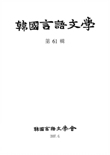- 영문명
- HwangSeokyoung’s Sonnim and It’s Literary Educational Application
- 발행기관
- 한국언어문학회
- 저자명
- 윤영옥(Yun Youngok)
- 간행물 정보
- 『한국언어문학』韓國言語文學 第61輯, 231~252쪽, 전체 22쪽
- 주제분류
- 어문학 > 한국어와문학
- 파일형태
- 발행일자
- 2007.06.30

국문 초록
영문 초록
The aim of Literary education is to provide linguistic, social, cultural experiences and to help learners understand the truth and totality of this world. It treats properties of literature itself and effects of literature in educational processes. Literary education needs to use works which can be sufficient to the aims synthetically. HwangSeokyoung’s Sonnim can provide the chances to consider this problems.
HwangSeokyoung’s Sonnim raises many disputes about the relations between the novel and the traditional narratives, the christianity and the ethnic performance ‘gut’, the acceptance of marxism and the division of the Korean peninsula, Korean War. The understanding about materials and backgrounds of this novle takes learners’ attentions to enlarge into socio-cultural contexts. This novel’s mutation of ‘gut’ contained the important references which is useful to grasp the interrelations between esthetic and socio-cultural worths.
It is important that the narrative strategies of HwangSeokyoung’s Sonnim raised the controversies about an established reality idea. This novel contained the invisible spirits of dead people into the real world. This aspect propel the learners to relate the notion with the socio-cultural contexts. Learners need to inquire the effects that the form and theme of ‘gut’ broke out. Learners should be considered the importance of the citizen’s choice and responsibility and discussed the motives of which the representations of that events treated.
Literary education help learners fill up the blanks in th text and enlarge the text into the of the life. The educational acceptance of Hwang Seokyoung’s Sonnim will provide one case of the processes that learners understand the novel and make themselves’ location in the world.
HwangSeokyoung’s Sonnim raises many disputes about the relations between the novel and the traditional narratives, the christianity and the ethnic performance ‘gut’, the acceptance of marxism and the division of the Korean peninsula, Korean War. The understanding about materials and backgrounds of this novle takes learners’ attentions to enlarge into socio-cultural contexts. This novel’s mutation of ‘gut’ contained the important references which is useful to grasp the interrelations between esthetic and socio-cultural worths.
It is important that the narrative strategies of HwangSeokyoung’s Sonnim raised the controversies about an established reality idea. This novel contained the invisible spirits of dead people into the real world. This aspect propel the learners to relate the notion with the socio-cultural contexts. Learners need to inquire the effects that the form and theme of ‘gut’ broke out. Learners should be considered the importance of the citizen’s choice and responsibility and discussed the motives of which the representations of that events treated.
Literary education help learners fill up the blanks in th text and enlarge the text into the of the life. The educational acceptance of Hwang Seokyoung’s Sonnim will provide one case of the processes that learners understand the novel and make themselves’ location in the world.
목차
Ⅰ. 서론
Ⅱ. 문화교육으로서의 문학교육
Ⅲ. 『손님』의 서사 구조와 문화교육
Ⅳ. 결론
〈참고문헌〉
[Abstract]
Ⅱ. 문화교육으로서의 문학교육
Ⅲ. 『손님』의 서사 구조와 문화교육
Ⅳ. 결론
〈참고문헌〉
[Abstract]
키워드
해당간행물 수록 논문
참고문헌
최근 이용한 논문
교보eBook 첫 방문을 환영 합니다!

신규가입 혜택 지급이 완료 되었습니다.
바로 사용 가능한 교보e캐시 1,000원 (유효기간 7일)
지금 바로 교보eBook의 다양한 콘텐츠를 이용해 보세요!



